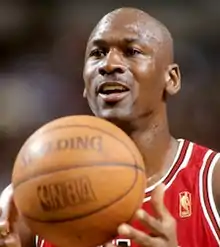Jordan Rules
The Jordan Rules were a successful defensive basketball strategy employed by the Detroit Pistons against Michael Jordan in order to limit his effectiveness in any game. Devised by Chuck Daly and his assistants at the time, Ron Rothstein and Dick Versace, after Jordan scored 59 points against them in April 1988, the Pistons' strategy was "to play him tough, to physically challenge him and to vary its defenses so as to try to throw him off balance."[1] Sometimes the Pistons would overplay Jordan to keep the ball from him. "I don't think Chuck Daly wanted to hurt him, he was just looking to wear him out."[2] Sometimes they would play him straight up, more often they would run a double-team at him as soon as he got the ball to force him to go left, which he was less successful in doing. He never wanted opponents to think they were good enough to affect him or his play. Winning the psychological battle was as important to Jordan as the physical one.[3] Additionally, whoever Jordan was guarding on defense, Detroit would force that player to pass the basketball in order to make Jordan work extremely hard on both ends of the court, thus increasing his fatigue level and rendering him less effective.[4][5]
| ||
|---|---|---|
This strategy has also sometimes been employed against other prolific scoring guards.[6] The Jordan Rules were an instrumental aspect of the rivalry between the "Bad Boys" Pistons and Jordan's Chicago Bulls in the late 1980s and early 1990s. This style of defense limited players including Jordan from entering the paint and was carried out by Dennis Rodman and Bill Laimbeer.
The Jordan Rules were most effective for the Pistons during their first three playoff meetings with the Bulls. Detroit beat Chicago four games to one in 1988 then defeated the Bulls in six games in 1989 and seven games in 1990. The Pistons won back-to-back championships after eliminating the Bulls. Finally, in 1991, the Bulls defeated the Pistons in the playoffs, neutralizing the Jordan Rules with their triangle offense, orchestrated by coach Phil Jackson and assistant Tex Winter. They swept the Pistons in the 1991 Eastern Conference Finals. Soon after, the Bulls captured their first-ever NBA title, beating the Los Angeles Lakers in the NBA Finals 4 games to 1. The Pistons qualified for the playoffs again in 1992, 1996, 1997, 1999, and 2000, not advancing to the second round until 2002.
This strategy was later used by the New York Knicks from 1992 to 1998. However, the Knicks were not as successful as Detroit in containing Jordan and the Bulls. Jordan faced New York in the NBA Playoffs in 1991, 1992, 1993, and 1996. The Bulls eliminated the Knicks and captured NBA titles in all four of those seasons.
In an interview with Sports Illustrated, then Detroit Pistons coach Chuck Daly described the Jordan Rules as:[7]
If Michael was at the point, we forced him left and doubled him. If he was on the left wing, we went immediately to a double team from the top. If he was on the right wing, we went to a slow double team. He could hurt you equally from either wing—hell, he could hurt you from the hot-dog stand—but we just wanted to vary the look. And if he was on the box, we doubled with a big guy. The other rule was, any time he went by you, you had to nail him. If he was coming off a screen, nail him. We didn't want to be dirty—I know some people thought we were—but we had to make contact and be very physical.
When doing an ESPN 30 for 30, Joe Dumars said:[8]
It was like the Da Vinci Code, the formula to Coca-Cola and the Jordan rules.
References
- 30 for 30: Bad Boys. Dir. Zak Levitt. Perf. Isiah Thomas and Dennis Rodman. ESPN Films, 2014. DVD.
- Bucher, Ric. "How Michael Jordan Broke 'The Jordan Rules'". Bleacher Report. Retrieved April 23, 2021.
- Bucher, Ric. "How Michael Jordan Broke 'The Jordan Rules'". Bleacher Report. Retrieved April 23, 2021.
- Jack McCallum (November 6, 1989). "Mission Impossible". Sports Illustrated. Archived from the original on April 14, 2002. Retrieved January 21, 2023.
- Jeff Zillgitt (April 27, 2020). "'The Last Dance': How the Pistons employed 'The Jordan Rules' against Michael". USA Today. Retrieved January 21, 2023.
- "PISTONS: Reliving the Pistons-Bulls Rivalry". NBA.com. Archived from the original on September 27, 2005.
- McCallum, Jack (May 29, 2007). "'Jordan Rules' revisited (cont.)". Archived from the original on October 20, 2012. Retrieved December 11, 2013.
- James Herbert (May 15, 2020). "The Jordan Rules: What 'The Last Dance' documentary doesn't say about Pistons' defense against Michael Jordan". CBS Sports. Retrieved January 21, 2023.

